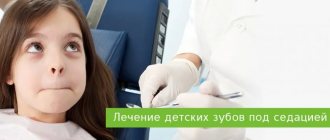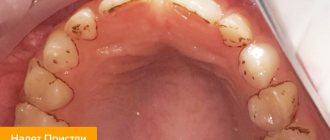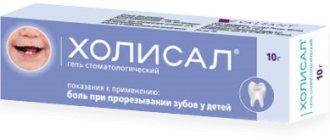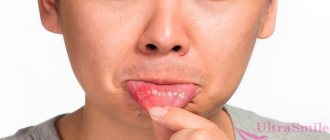A person's first teeth begin to erupt before the age of one, when milk still serves as the main food. That is why Hippocrates gave the name “milk” to non-permanent teeth, the replacement of which with permanent ones begins at 5-6 years. Considering that milk contains the main building material for teeth - calcium, it is necessary to follow a proper diet in the future. And if it is violated, there is a high probability of tooth decay in children, which will require treatment of baby teeth in order to avoid problems in the future.
Milk teeth are formed during the period of intrauterine development, at 10-12 weeks, and at 26-27 weeks the formation of incisors begins.
There are a number of differences between baby and permanent teeth:
- dairy ones have a smaller crown;
- the enamel layer is thinner, so baby teeth are more susceptible to destruction, and at the age of 5–6 years they themselves fall out;
- Before the permanent teeth begin to grow, the roots of the milk teeth begin to dissolve.
Usually, a baby’s first tooth appears around six months. Parents notice swelling of the gum, then it becomes thinner and a tooth can be seen showing through the gum. When the gums break through, the first baby tooth will appear on the surface. It is generally accepted that teeth should erupt at a certain time in accordance with the sequence, but this is quite arbitrary and in practice there are deviations in one direction or another.
The delayed appearance of the first teeth does not indicate a delay in the development of the child. This may be determined by heredity, lack of vitamins or previous infection.
At 2.5-3 years old, a child has 20 teeth: 4 upper and lower incisors, 4 canines and 8 chewing units. All of them then fall out and are replaced by permanent teeth, to which 12 more are added (with wisdom teeth). During the first year of a child’s life, it is necessary to regularly show all medical specialists to monitor his development. A dental examination is also required, which some parents ignore, considering it unimportant for the child’s health.
Dental status of children
The condition of the oral cavity directly affects the entire body:
- pathological changes can lead to malfunctions of internal organs (kidneys, gastrointestinal tract) and the appearance of diseases;
- with an incorrect bite, breathing through the nose is impaired, which leads to dysfunction of organs and organ systems;
- caries and the complications caused by it cause sore throat and other diseases, the causative agents of which are streptococci, which cause carious changes in the teeth.
The body characteristics of young children and their underdeveloped immune system determine that they are at risk for developing diseases. Since the body is a single interconnected whole, the condition of the oral cavity is given the same close attention as other organs. That is why WHO has proposed that dental examinations be carried out according to a specific schedule. If a child has a toothache, an immediate unscheduled visit to a pediatric dentist is necessary for an examination and prescription of a course of treatment.
Do I need to treat rotten teeth?
Of course, it is necessary to treat any damage to baby teeth. The loss of one or more milk units can affect the correct formation of the bite in later life. In addition, the destruction of hard tissues inevitably leads to inflammatory processes in the surrounding soft tissues. If you do not deal with the problem in a timely manner, then there is a high risk of developing an abscess, meningitis, sepsis, etc.
Quite often, dental caries does not manifest itself in any way until the child’s immune system is weakened due to illness or a common cold. The consequences can be quite serious: sinusitis, pain in the ears (otitis and other problems), digestive problems, intestinal disorders and stool disorders, as well as severe stomach pain.
In addition, rotten teeth look very unsightly even in a child. Older children may begin to feel complex about their appearance; they will develop self-doubt and tightness. That is why it is very important to periodically check the condition of your baby’s teeth, because it is much easier to eliminate the problem at an early stage.
previous post
The difference between paid and free anesthesia
next entry
First examination of a newborn
Immediately after birth, the baby is examined by specialists, including a dentist. This is important because an assessment of the general condition and reflexes is necessary, but the primary question is the size of the frenulum of the tongue. With a shortened frenulum, the child will not be able to grasp the nipple and suck normally. External examination and assessment of tongue movement does not always reveal abnormalities. This may appear in the next 5-15 days:
- smacking sounds appear during feeding;
- a long feeding process: the baby sucks, then pauses for a while and starts sucking again;
- Mom develops cracks and pain in her nipples;
- the child is capricious at the breast;
- is gaining weight poorly.
If such symptoms are noticed, you should make an appointment with a doctor so that he can examine the baby, determine the size of the frenulum and make the appropriate prescriptions.
At what age should a child be taken to the dentist for the first time?
According to the WHO schedule, you should go to the dentist for the first time when the child is 9 months old. Some doctors indicate an age of 11-12 months. During a dental examination, several parameters are assessed.
1. How many teeth are there?
Based on the number of teeth present, the child’s development is assessed and pathologies are diagnosed. It is normal for children to erupt 5-8 milk teeth by the age of 9-12 months.
2. What condition are the teeth in?
From the first days of teeth appearing there is a danger of caries. Also, teeth should be examined for non-carious lesions - hypoplasia, in order to exclude the appearance and development of caries.
3. What is the condition of the mucous membranes?
Small children put everything in their mouths, so they are at risk for infectious diseases - stomatitis and intestinal infections. The more common fungal form of stomatitis, which must be treated promptly to avoid complications.
At the age of 9-12 months, a dental examination is more necessary for preventive purposes. The doctor will tell you what toothpaste to use, what toothbrush to choose, and how to teach your child hygiene. Until the child reaches two or three years of age, visits to the dentist should be regular - every 3-5 months.
The most common diseases of teeth and gums in children
One of the most common gum diseases in childhood is chronic catarrhal gingivitis. It occurs due to poor oral hygiene at home and insufficient visits to the dentist. The causes of the disease also lead to methods to combat it.
“Try to brush your teeth more thoroughly and go to the dentist for professional oral hygiene once every six months. In addition to the procedure itself, proper oral hygiene is also taught at home and the so-called controlled brushing of teeth is performed, that is, under the supervision of a doctor, the child shows how he has mastered the skill, and thereby increases the likelihood that oral hygiene at home will be performed more efficiently. carefully,” says Dr. Arutyunova.
Chronic aphthous stomatitis often occurs in younger children. This is due to the fact that, trying to reduce discomfort during teething and starting to explore the world around them, babies put everything in their mouths. As a result, small but rather painful ulcers with smooth outlines appear on the mucous membrane - aphthae. As a rule, they are treated by irrigating the mucous membrane with antibacterial sprays several times a day and applying a special gel. Among folk remedies, we can recommend sea buckthorn oil, which promotes healing and helps relieve discomfort. All medications must be prescribed by a doctor!
If we talk about dental diseases, then it all starts with banal dental deposits, flowing into caries, which in an advanced form turns into pulpitis of the baby tooth and even periodontitis.
Toothache in children
You should not think that baby teeth don’t hurt. Problems can arise even before birth if the expectant mother suffered an infectious disease in the first 12 weeks, which led to pathology in the development of tooth buds. However, even with normal tooth development, there is no guarantee that caries will not develop. Baby teeth are easily affected, and the disease is transmitted to neighboring teeth. Caries progresses very quickly, complications appear (pulpitis, periodontitis), so even at such an early age it is necessary to carry out dental treatment in children.
At five to seven years old, the first molars appear - the sixth chewing teeth, and they can also turn out to be problematic. The chewing surface of molars has deep crevices in the enamel, where the most favorable conditions for reproduction are created for microorganisms. The products of their vital activity become the determining factor for the development of carious processes.
In addition, the vast majority of young children are very fond of sweets, which further aggravates the situation: holding candy in the mouth for a long time or chewing gum with sugar lead to the constant presence of sugar in the oral cavity.
Hygienic procedures are also difficult to carry out: children generally do not like to brush their teeth even with the most “delicious” toothpaste. In addition, it is not easy for a small child to handle a toothbrush, let alone floss. Children, as a rule, are also not given mouthwashes.
Why do baby teeth rot?
As in adults, in children, caries and subsequent tooth decay is caused by the decomposition of food debris stuck between them. A child’s mouth contains a huge number of microorganisms, because children love sweet, sour, salty foods and foods with strong “chemical” tastes. During their life, microorganisms produce acid, which destroys enamel.
Add to this process the deteriorating environment, a small amount of mineral salts in the water and not very thorough children's dental care. It is not surprising that according to statistics, every second child today, already at the age of 3, suffers from caries and rotting of baby teeth.
The most common external causes of rotten teeth in children include:
- insufficient brushing of teeth or lack of oral hygiene;
- improper unbalanced diet - lack of vitamins, minerals, excessive consumption of sweets and soda;
- drinking water with low fluoride content;
- heredity;
- mechanical damage to tooth enamel;
- unfavorable environmental conditions in the region or area of residence of the child.
Rotten teeth in children are often caused by internal causes, which include:
- Chronic diseases of the gastrointestinal tract.
- Prematurity. In babies who were born prematurely, the enamel of the tooth buds is not sufficiently developed. Weak teeth are more susceptible to various negative factors.
- Pathologies of the endocrine system that cause changes in hormonal balance in the body.
- Liver diseases.
Various streptococcal infections, leukemia, anemia, cancer, diabetes, scarlet fever, and chickenpox also have a detrimental effect on dentin. Hard tissue is affected from the inside, and retrograde caries appears. A child’s teeth also often begin to rot after taking tetracyclines and antihistamines.
Teeth often begin to deteriorate even during the period of weakened immunity of the baby. Due to prolonged stress, poor nutrition, and illness, the child’s immune defense decreases, and the teeth immediately react to any adverse factors.
How to prevent dental diseases in children?
Unlike adults, caries develops in children almost asymptomatically, without causing discomfort. However, small children sometimes complain of pain in their teeth. What does this mean and what to do if a child has a toothache? Firstly, this may already be a sign of pulpitis or periodontitis. Secondly, it is necessary to visit a pediatric dentist at the first, even the most minor, complaints of the child. However, following the recommendations of doctors will help you avoid many problems:
- Parents should regularly examine the child’s oral cavity to see if the enamel has darkened, if the gums have changed color, and if there is too much plaque on the teeth.
- Prepare your diet correctly. Limiting sweets, add more vegetables and fruits. While eating, you should pay attention to how the baby chews food: if he always chews on one side, he needs to be examined by a dentist.
- Properly organize oral care. The brushes should be attractive and soft, and the toothpaste should be safe and pleasant to the taste.
- If a child has teeth grinding, you should immediately consult a doctor in order to stop the disease at the initial stage. Otherwise, this can lead to high tooth sensitivity, caries and related complications.
- In addition to home examinations, professional examinations by a pediatric dentist are mandatory.
- Examinations and treatment of a child’s baby teeth should be performed by a pediatric dentist. Such a doctor must be not only a good specialist, but also a psychologist who knows how to find the right approach to a small patient. This will help in the future to avoid the fear of the dental chair, which is typical even for many adults.
dental treatment for children, a pediatric dentist carries out preventive measures for healthy children:
- seals the fissures of chewing teeth;
- coats teeth with fluoride varnish to protect enamel;
- professionally brushes teeth.
In addition, the doctor advises parents on how to take care of their child’s oral cavity, and tells children how to brush their teeth. As soon as the first teeth appear, you need to clean your mouth every day with rubber finger brushes. Toothpaste is used for care when the child is one to one and a half years old.
Dentists have a good way to check how accurately you follow their recommendations: checking with a special coloring composition helps detect plaque on your baby’s teeth.
The time will come for baby teeth to fall out anyway...
Having learned after a visit to the doctor why the child’s teeth hurt, parents are often in no hurry to treat baby teeth, believing that the time will come for them to fall out anyway, but when the permanent teeth grow, they must be carefully monitored. This is a rather dangerous misconception that can lead to a deterioration in the child’s health, because the body is an integral system where everything is interconnected, and dental problems can become a “trigger” for many other diseases. At the same time, diseased baby teeth can lead to the development of pathologies in permanent teeth.
If baby teeth are not treated on time and they are significantly damaged, they should be removed. The resulting void in the dentition can cause problems with bite. In this case, they resort to installing orthodontic plates, and at the age of 10-12 years, braces are installed. If the incisors are removed, problems may arise with the pronunciation of individual sounds, in which case you will have to contact a speech therapist. So it is better to avoid troubles than to deal with them later; in this matter, the best solution is prevention.
In addition, acute toothache and a visit to the dentist in this case will become stressful for the child. Sedation or general anesthesia is often required.
Do baby teeth need to be treated? What are the consequences of ignoring problematic baby teeth in the future?
The doctor’s answer to this question is clear, says FAN’s .
"Of course yes. Baby teeth need to be treated! If you leave everything to chance, the child will inevitably suffer from pain and discomfort. Moreover, it is advisable not to delay this process so that the little patient does not have a negative experience in dental treatment,” explains Victoria Arutyunova.
Of course, it is better to limit ourselves to preventive measures, but if, after all, time has already been lost, then therapeutic manipulations are absolutely necessary, since the infection gets into the tooth, and then through the nerves and canals it enters the bone and ultimately can infect and damage the germ of a new tooth . If this happens, then there are several scenarios for how the situation could develop further. The rudiment may die altogether and stop developing, or the tooth may erupt with a slight visual defect. Typically, this phenomenon is called enamel hypoplasia. In addition, possible complications include swelling, periostitis, inflammation of the gums with subsequent release of infection and pus and, accordingly, painful removal and an incision to drain the exudate.
Naturally, this procedure, which is unpleasant for the child, causes persistent negativity and provokes difficulties in further interaction with the pediatric dentist.
“In addition, during such removals, anesthesia may not work well, since the infectious exudate does not allow the anesthetic to penetrate deep enough. The child will remember such a visit for a long time, so it is better to treat without leading to such complications,” says our expert.
What are the consequences of a frivolous attitude towards children's health? If you still have to remove a baby tooth, the place will be empty, and nature, as we know, does not tolerate emptiness. As a result, neighboring teeth will begin to tilt towards the missing one. As a result, the further appearance of permanent teeth will be difficult; they will erupt in the wrong position and at the wrong time, which will cause orthodontic problems. With a high degree of probability, in the near future, parents will have to seek the services of an orthodontist to correct the situation with the help of plates or braces.
pixabay.com/
Anesthesia in pediatric dentistry
Those manipulations that an adult is able to calmly endure will become the strongest test for a child, both physically and psychologically. Pain management in pediatric dentistry is given a special place, because the psychological trauma from pain received in childhood at a dentist’s appointment will accompany a person throughout his life, and the fear of the dental office will turn into a real phobia. The use of anesthesia by pediatric dentists will remove pain and, accordingly, fear of procedures.
The use of anesthesia in pediatric dentistry has a number of features:
- for the youngest there are restrictions on the use of most products that can be used from 4 years old;
- the doctor must have experience and high qualifications to accurately calculate the active drug;
- children are afraid of treatment of baby teeth , and in general of all dental instruments, especially syringes and injections;
- Quite often, children experience allergic reactions to anesthetic drugs.
Prevention of dental diseases
Two phases characterize caries :
Phase I – “demineralization” of teeth. Dissolution of enamel crystals under the tooth surface. Outwardly, everything looks OK, only white, chalk-like spots signal danger. At the first stage, everything is curable, but with the condition of intensive dental care. If sugar continues to be present, your teeth will have a particularly hard time.
Phase II - the appearance of a hole in the tooth - caries. But this is already incurable!
Fluorine is nature itself
Fluoride is not only found in our saliva, it is a natural component of our environment and a mineral that can be called an absolute “power” for teeth and bones. Fluoride increases the resistance of enamel to acids.
Anesthesia in pediatric dentistry, types
1. Application of local anesthesia
Most often used. It is carried out in 2 stages - “freezing” with a gel or spray, after which the drug is injected. Typically, children of any age tolerate this type of anesthesia well. Sensitivity is not completely lost; minimum contraindications.
2. Use of sedation
A sedative is inhaled. The child relaxes, but remains conscious. This is not anesthesia in its “pure form”; there is no strong analgesic effect. It is often used with an injection of an anesthetic drug.
3. Use of general anesthesia
It is used in extreme cases, because the risk of complications after dental treatment under general anesthesia exceeds that with local anesthesia. The pediatric dentist must have good reasons for using general anesthesia, because this causes profound depression of the nervous system, which can be followed by complications. The primary thing is to correctly calculate the dosage and take into account the individual characteristics of the small patient.
The anesthetic drug is given by inhalation: by inhaling the vapor of the drug, the child falls asleep. The doctor gets the opportunity to quickly and calmly treat the tooth, and the child will not feel pain or get stressed.
Prevention of children's teeth - care
Our body’s “laboratory” produces fluoride in saliva, but it is no longer enough to effectively protect our teeth. Too many Big Macs, Snickers, and chewy candies have made it difficult for saliva to perform this function. She needs help:
- brush your teeth twice a day with a toothpaste containing fluoride;
- once a week, carry out intensive fluoridation with products containing fluoride (gels, for example);
- coat your teeth with fluoride varnish monthly;
- eat fluoridated salt.
If plaque is not regularly removed from teeth, it turns into tartar, visible on the surface of the teeth. Tartar increases in size and imperceptibly “grows” under the gums towards the root of the tooth. A thin layer of tartar is stained by exposure to nicotine, tea or red wine.
Fluoride varnish coating is professional protection against caries. Professional cleaning means removing tartar, incl. deposits invisible to the eye, which should be carried out by the dentist at least twice a year.
But that is not all. Only polishing finally rids the roots of residual layers of tartar.
Moreover. Polishing makes it more difficult for stone to form. Polishing all surfaces of the teeth after removing plaque using brushes, polishing heads, superflosses, strips, brushes and pastes allows you to make your teeth very smooth. Only with the help of professional cleaning can gum disease be cured. And the degree of its success can be checked with the tip of your tongue!
Alternative to general anesthesia
The safest alternative is sedation. Through a mask, the patient inhales a mixture of oxygen and nitrous oxide. A slight relaxation and drowsiness appears, and the feeling of fear disappears. At the same time, the child is conscious and able to do what the doctor says.
Sedation cannot be considered anesthesia in the full sense, but it still provides an analgesic effect, and in combination with an injection of an anesthetic it provides a good result. The gas composition is supplied through a device that controls the dose of the mixture, the time of sedation, allowing you to smoothly enter and exit “half-sleep”. After stopping the supply of the mixture, the effect lasts about 10 minutes.
Why carry out prophylaxis if baby teeth fall out?
Prophylaxis reduces the risk of dental disease in permanent teeth in adolescents and children by 80% - this has been proven by many years of practice.
Preventive measures should begin BEFORE the baby is born, starting from the fifth week of pregnancy. Expectant mothers are recommended to adhere to a specially developed method of antenatal caries prevention in children:
- include foods with a high content of calcium and phosphorus in the diet (fermented milk products, seafood);
- take vitamins prescribed by the doctor;
- do not ignore the sanitation of the oral cavity in the second trimester and the treatment of all existing carious teeth.
A pediatric dentist will advise you on how to prevent caries in children, and from the age of three, prevention is carried out in an outpatient clinic. The cost of preventive procedures will be much less than solving dental problems in an older child.
Stages of tooth decay
Any damage to a child’s teeth does not develop immediately, but gradually. The first stage is characterized by the accumulation of a large number of pathogens on the enamel, which over time form a dense dark film - spots. Also, the beginning of the destruction process may be indicated by the appearance of bad breath.
At the same time, tissue sensitivity increases, and the baby may experience discomfort when eating cold or, conversely, hot food. Also at this stage, small black spots and cavities can be found on the teeth. At this time, the deeper tissues of the tooth begin to deteriorate. As a result, the child may complain of severe pain with any mechanical impact and even without it.
Further, the process affects the nerve endings, so the pain may decrease or disappear completely. This suggests that very soon the decay will reach the root of the tooth, as a result of which the unit will most likely have to be removed surgically. The sooner parents seek help from a professional dentist, the greater the chance of saving the tooth.











